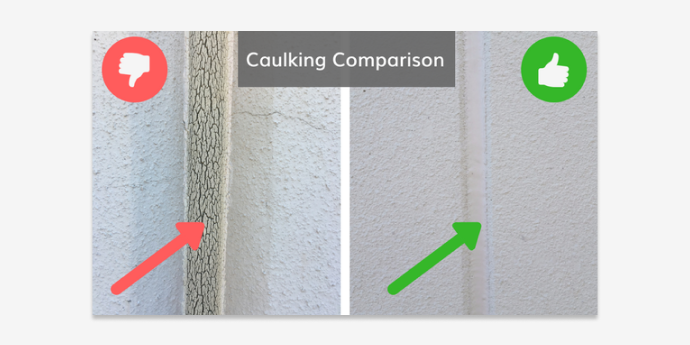As you spend more time reading the Western blog, you may notice something about caulking (or sealants).
Namely, that we mention the importance of them constantly.
What’s so special about caulking?
For starters, caulking is the first line of defense against water getting into your building … and failed caulking is the number one cause of water issues in all types of buildings.
The good news is that there’s a straightforward way to avoid those issues.
Our best tip for making your maintenance program more cost-effective
If you want one tip that will give you the most significant results in the shortest time, it’s this:
Make sure to inspect your caulk joints once a year to determine their condition.
All you need to do is have you or someone on your team go outside and take a look at them to see if there are any signs of deterioration.

The caulking on the left is completely toasted. It doesn’t matter what kind of condition the rest of the building components are in … water is going to get into the building through these deteriorated joints.
That will undoubtedly make the tenants mad, but there’s also the possibility of costly interior damage.
So that’s one thing you can do today – inspect the condition of your caulk joints.
Why caulking is the most important thing you need to think about for exterior building maintenance
The book Construction Waterproofing Handbook, by Michael T. Kubal does a great job of illustrating why caulking is so crucial. (He refers to it as sealants, but for this lesson, we’re using the terms interchangeably.)
You could read the whole thing (and your maintenance would improve as a result), but I’m going to share the highlights about the importance of caulking.
The main thing you need to know is that your building is made up of a bunch of different components, and those components all need to work correctly for your building to be watertight.
If one component fails, it doesn’t matter what kind of shape the others are in – water is going to get into your building.
It’s like the offensive line in football. Four of the five guys can execute their block flawlessly. But if that fifth guy misses his block, the quarterback is getting sacked. It doesn’t matter how well those four guys blocked … the unit still failed to its one job.
The only way your multiple building components can work is if each one is properly transitioned into the other parts. That “transition” we’re talking about is usually the caulking.
Why so many building managers frequently deal with water issues
Kubal sums up what we’re talking about here perfectly.
All individual envelope systems must be adequately transitioned into other components … Often the tradesworkers completing this work are not aware of, trained in, or supervised in enveloping the building properly. And this is the number one cause of water infiltration in all types of structures.
It makes sense why caulking is so often overlooked by building managers. Its size and cost seem relatively small compared to other parts of your building. But what’s staggering is how often contractors overlook this crucial component.
So, don’t make the mistake of dismissing the importance of caulking. And don’t just trust any contractor to take care of this component that’s so crucial to your success.
If there’s one thing you should take away from this lesson, it’s this last excerpt from Kubal’s book.
Since sealants are a minor portion of overall construction scope, they receive an equal amount of effort in their design and installation. Yet because they are the first line of defense against water infiltration, sealant failures can cause an unequal proportion of problems and resulting damage.
Just by understanding that and acting accordingly, your maintenance program will be miles ahead of the industry standard.

 by
by 